Jianyuan Guo
Circle-RoPE: Cone-like Decoupled Rotary Positional Embedding for Large Vision-Language Models
May 22, 2025Abstract:Rotary Position Embedding (RoPE) is a widely adopted technique for encoding relative positional information in large language models (LLMs). However, when extended to large vision-language models (LVLMs), its variants introduce unintended cross-modal positional biases. Specifically, they enforce relative positional dependencies between text token indices and image tokens, causing spurious alignments. This issue arises because image tokens representing the same content but located at different spatial positions are assigned distinct positional biases, leading to inconsistent cross-modal associations. To address this, we propose Per-Token Distance (PTD) - a simple yet effective metric for quantifying the independence of positional encodings across modalities. Informed by this analysis, we introduce Circle-RoPE, a novel encoding scheme that maps image token indices onto a circular trajectory orthogonal to the linear path of text token indices, forming a cone-like structure. This configuration ensures that each text token maintains an equal distance to all image tokens, reducing artificial cross-modal biases while preserving intra-image spatial information. To further enhance performance, we propose a staggered layer strategy that applies different RoPE variants across layers. This design leverages the complementary strengths of each RoPE variant, thereby enhancing the model's overall performance. Our experimental results demonstrate that our method effectively preserves spatial information from images while reducing relative positional bias, offering a more robust and flexible positional encoding framework for LVLMs. The code is available at [https://github.com/lose4578/CircleRoPE](https://github.com/lose4578/CircleRoPE).
Bridging Sign and Spoken Languages: Pseudo Gloss Generation for Sign Language Translation
May 21, 2025Abstract:Sign Language Translation (SLT) aims to map sign language videos to spoken language text. A common approach relies on gloss annotations as an intermediate representation, decomposing SLT into two sub-tasks: video-to-gloss recognition and gloss-to-text translation. While effective, this paradigm depends on expert-annotated gloss labels, which are costly and rarely available in existing datasets, limiting its scalability. To address this challenge, we propose a gloss-free pseudo gloss generation framework that eliminates the need for human-annotated glosses while preserving the structured intermediate representation. Specifically, we prompt a Large Language Model (LLM) with a few example text-gloss pairs using in-context learning to produce draft sign glosses from spoken language text. To enhance the correspondence between LLM-generated pseudo glosses and the sign sequences in video, we correct the ordering in the pseudo glosses for better alignment via a weakly supervised learning process. This reordering facilitates the incorporation of auxiliary alignment objectives, and allows for the use of efficient supervision via a Connectionist Temporal Classification (CTC) loss. We train our SLT mode, which consists of a vision encoder and a translator, through a three-stage pipeline, which progressively narrows the modality gap between sign language and spoken language. Despite its simplicity, our approach outperforms previous state-of-the-art gloss-free frameworks on two SLT benchmarks and achieves competitive results compared to gloss-based methods.
Low-Precision Training of Large Language Models: Methods, Challenges, and Opportunities
May 02, 2025Abstract:Large language models (LLMs) have achieved impressive performance across various domains. However, the substantial hardware resources required for their training present a significant barrier to efficiency and scalability. To mitigate this challenge, low-precision training techniques have been widely adopted, leading to notable advancements in training efficiency. Despite these gains, low-precision training involves several components$\unicode{x2013}$such as weights, activations, and gradients$\unicode{x2013}$each of which can be represented in different numerical formats. The resulting diversity has created a fragmented landscape in low-precision training research, making it difficult for researchers to gain a unified overview of the field. This survey provides a comprehensive review of existing low-precision training methods. To systematically organize these approaches, we categorize them into three primary groups based on their underlying numerical formats, which is a key factor influencing hardware compatibility, computational efficiency, and ease of reference for readers. The categories are: (1) fixed-point and integer-based methods, (2) floating-point-based methods, and (3) customized format-based methods. Additionally, we discuss quantization-aware training approaches, which share key similarities with low-precision training during forward propagation. Finally, we highlight several promising research directions to advance this field. A collection of papers discussed in this survey is provided in https://github.com/Hao840/Awesome-Low-Precision-Training.
ADEM-VL: Adaptive and Embedded Fusion for Efficient Vision-Language Tuning
Oct 23, 2024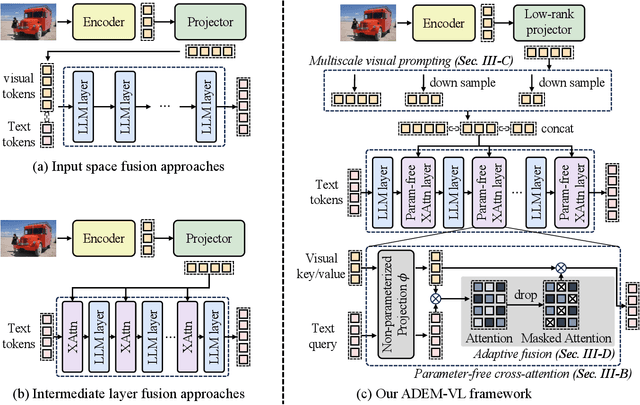
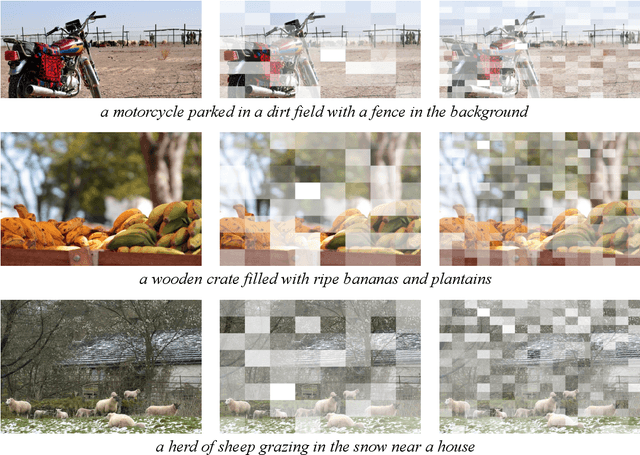
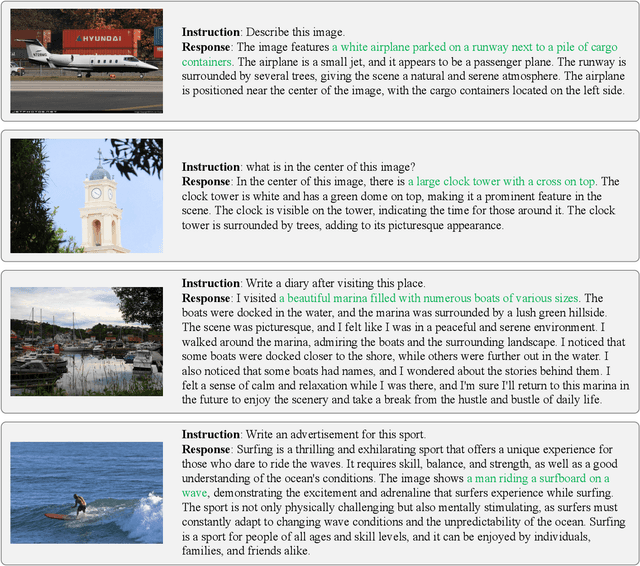
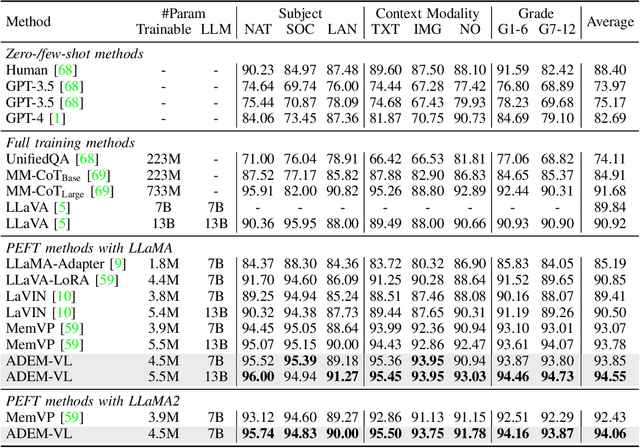
Abstract:Recent advancements in multimodal fusion have witnessed the remarkable success of vision-language (VL) models, which excel in various multimodal applications such as image captioning and visual question answering. However, building VL models requires substantial hardware resources, where efficiency is restricted by two key factors: the extended input sequence of the language model with vision features demands more computational operations, and a large number of additional learnable parameters increase memory complexity. These challenges significantly restrict the broader applicability of such models. To bridge this gap, we propose ADEM-VL, an efficient vision-language method that tunes VL models based on pretrained large language models (LLMs) by adopting a parameter-free cross-attention mechanism for similarity measurements in multimodal fusion. This approach only requires embedding vision features into the language space, significantly reducing the number of trainable parameters and accelerating both training and inference speeds. To enhance representation learning in fusion module, we introduce an efficient multiscale feature generation scheme that requires only a single forward pass through the vision encoder. Moreover, we propose an adaptive fusion scheme that dynamically discards less relevant visual information for each text token based on its attention score. This ensures that the fusion process prioritizes the most pertinent visual features. With experiments on various tasks including visual question answering, image captioning, and instruction-following, we demonstrate that our framework outperforms existing approaches. Specifically, our method surpasses existing methods by an average accuracy of 0.77% on ScienceQA dataset, with reduced training and inference latency, demonstrating the superiority of our framework. The code is available at https://github.com/Hao840/ADEM-VL.
Free Video-LLM: Prompt-guided Visual Perception for Efficient Training-free Video LLMs
Oct 14, 2024



Abstract:Vision-language large models have achieved remarkable success in various multi-modal tasks, yet applying them to video understanding remains challenging due to the inherent complexity and computational demands of video data. While training-based video-LLMs deliver high performance, they often require substantial resources for training and inference. Conversely, training-free approaches offer a more efficient alternative by adapting pre-trained image-LLMs models for video tasks without additional training, but they face inference efficiency bottlenecks due to the large number of visual tokens generated from video frames. In this work, we present a novel prompt-guided visual perception framework (abbreviated as \emph{Free Video-LLM}) for efficient inference of training-free video LLMs. The proposed framework decouples spatial-temporal dimension and performs temporal frame sampling and spatial RoI cropping respectively based on task-specific prompts. Our method effectively reduces the number of visual tokens while maintaining high performance across multiple video question-answering benchmarks. Extensive experiments demonstrate that our approach achieves competitive results with significantly fewer tokens, offering an optimal trade-off between accuracy and computational efficiency compared to state-of-the-art video LLMs. The code will be available at \url{https://github.com/contrastive/FreeVideoLLM}.
Token Compensator: Altering Inference Cost of Vision Transformer without Re-Tuning
Aug 13, 2024


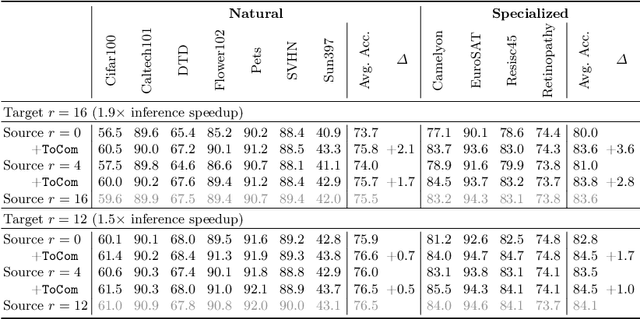
Abstract:Token compression expedites the training and inference of Vision Transformers (ViTs) by reducing the number of the redundant tokens, e.g., pruning inattentive tokens or merging similar tokens. However, when applied to downstream tasks, these approaches suffer from significant performance drop when the compression degrees are mismatched between training and inference stages, which limits the application of token compression on off-the-shelf trained models. In this paper, we propose a model arithmetic framework to decouple the compression degrees between the two stages. In advance, we additionally perform a fast parameter-efficient self-distillation stage on the pre-trained models to obtain a small plugin, called Token Compensator (ToCom), which describes the gap between models across different compression degrees. During inference, ToCom can be directly inserted into any downstream off-the-shelf models with any mismatched training and inference compression degrees to acquire universal performance improvements without further training. Experiments on over 20 downstream tasks demonstrate the effectiveness of our framework. On CIFAR100, fine-grained visual classification, and VTAB-1k, ToCom can yield up to a maximum improvement of 2.3%, 1.5%, and 2.0% in the average performance of DeiT-B, respectively. Code: https://github.com/JieShibo/ToCom
GeminiFusion: Efficient Pixel-wise Multimodal Fusion for Vision Transformer
Jun 04, 2024



Abstract:Cross-modal transformers have demonstrated superiority in various vision tasks by effectively integrating different modalities. This paper first critiques prior token exchange methods which replace less informative tokens with inter-modal features, and demonstrate exchange based methods underperform cross-attention mechanisms, while the computational demand of the latter inevitably restricts its use with longer sequences. To surmount the computational challenges, we propose GeminiFusion, a pixel-wise fusion approach that capitalizes on aligned cross-modal representations. GeminiFusion elegantly combines intra-modal and inter-modal attentions, dynamically integrating complementary information across modalities. We employ a layer-adaptive noise to adaptively control their interplay on a per-layer basis, thereby achieving a harmonized fusion process. Notably, GeminiFusion maintains linear complexity with respect to the number of input tokens, ensuring this multimodal framework operates with efficiency comparable to unimodal networks. Comprehensive evaluations across multimodal image-to-image translation, 3D object detection and arbitrary-modal semantic segmentation tasks, including RGB, depth, LiDAR, event data, etc. demonstrate the superior performance of our GeminiFusion against leading-edge techniques. The PyTorch code is available at https://github.com/JiaDingCN/GeminiFusion
SAM-DiffSR: Structure-Modulated Diffusion Model for Image Super-Resolution
Feb 27, 2024Abstract:Diffusion-based super-resolution (SR) models have recently garnered significant attention due to their potent restoration capabilities. But conventional diffusion models perform noise sampling from a single distribution, constraining their ability to handle real-world scenes and complex textures across semantic regions. With the success of segment anything model (SAM), generating sufficiently fine-grained region masks can enhance the detail recovery of diffusion-based SR model. However, directly integrating SAM into SR models will result in much higher computational cost. In this paper, we propose the SAM-DiffSR model, which can utilize the fine-grained structure information from SAM in the process of sampling noise to improve the image quality without additional computational cost during inference. In the process of training, we encode structural position information into the segmentation mask from SAM. Then the encoded mask is integrated into the forward diffusion process by modulating it to the sampled noise. This adjustment allows us to independently adapt the noise mean within each corresponding segmentation area. The diffusion model is trained to estimate this modulated noise. Crucially, our proposed framework does NOT change the reverse diffusion process and does NOT require SAM at inference. Experimental results demonstrate the effectiveness of our proposed method, showcasing superior performance in suppressing artifacts, and surpassing existing diffusion-based methods by 0.74 dB at the maximum in terms of PSNR on DIV2K dataset. The code and dataset are available at https://github.com/lose4578/SAM-DiffSR.
Data-efficient Large Vision Models through Sequential Autoregression
Feb 07, 2024



Abstract:Training general-purpose vision models on purely sequential visual data, eschewing linguistic inputs, has heralded a new frontier in visual understanding. These models are intended to not only comprehend but also seamlessly transit to out-of-domain tasks. However, current endeavors are hamstrung by an over-reliance on colossal models, exemplified by models with upwards of 3B parameters, and the necessity for an extensive corpus of visual data, often comprising a staggering 400B tokens. In this paper, we delve into the development of an efficient, autoregression-based vision model, innovatively architected to operate on a limited dataset. We meticulously demonstrate how this model achieves proficiency in a spectrum of visual tasks spanning both high-level and low-level semantic understanding during the testing phase. Our empirical evaluations underscore the model's agility in adapting to various tasks, heralding a significant reduction in the parameter footprint, and a marked decrease in training data requirements, thereby paving the way for more sustainable and accessible advancements in the field of generalist vision models. The code is available at https://github.com/ggjy/DeLVM.
Vision Superalignment: Weak-to-Strong Generalization for Vision Foundation Models
Feb 06, 2024Abstract:Recent advancements in large language models have sparked interest in their extraordinary and near-superhuman capabilities, leading researchers to explore methods for evaluating and optimizing these abilities, which is called superalignment. In this context, our paper delves into the realm of vision foundation models, focusing on the concept of weak-to-strong generalization, which involves using a weaker model to supervise a stronger one, aiming to enhance the latter's capabilities beyond the former's limits. We introduce a novel and adaptively adjustable loss function for weak-to-strong supervision. Our comprehensive experiments span various scenarios, including few-shot learning, transfer learning, noisy label learning, and common knowledge distillation settings. The results are striking: our approach not only exceeds the performance benchmarks set by strong-to-strong generalization but also surpasses the outcomes of fine-tuning strong models with whole datasets. This compelling evidence underscores the significant potential of weak-to-strong generalization, showcasing its capability to substantially elevate the performance of vision foundation models. The code is available at https://github.com/ggjy/vision_weak_to_strong.
 Add to Chrome
Add to Chrome Add to Firefox
Add to Firefox Add to Edge
Add to Edge